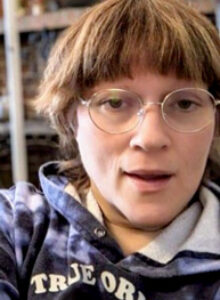“In daily life, seeing is intricately linked to understanding, with (visual objects)…functioning as preferred carriers of meaning and understanding. However, a closer look at visual practices demonstrates that the connection between sight, visual imagery, and understanding and interpreting them is significantly more complex than one might think” (Beiweis and Briel, 2024).

In fact, our “[a]bility to pinpoint the exact location and size of things varies from one person to the next, and even within our own individual field of vision” (Anwar, 2020).
Autism and Visual Sensory Overload
While humans perceive the world through more senses than vision alone, there is far more research on vision than on any other sensory modality—[B]ecause the available, present-day technology is better suited for studying vision than for studying other [sensory] modalities (Hutmacher, 2019).
People “assume [their] perception is a perfect reflection of the physical world around us,” but studies show that “each of us has a unique visual fingerprint” (Anwar, 2020). This may be especially true for those of us on the Spectrum, whose worlds can be truly chaotic and overwhelming. We tend to be sensitive to our environment and have easily overloaded sensory systems.
Prevalence in ASD
According to a study by the Geneva Centre for Autism in Toronto, Canada, as many as 80% of individuals with autism report distorted perception. The most commonly reported were difficulties with depth perception; distorted perception of size, shape, and motion; and seeing only small details rather than the whole (Autism – More than Meets the Eye, 2022).
Fragmented, Frightening World
In her book, Nobody Nowhere (1992), the late Donna Williams wrote, “Colors and things and people would fly, doors would get kicked in, and sometimes faces would, too. But it was never whole people, only their pieces.” Her book is a glimpse into the often frightening world in which many with ASD live.
The site, Goodreads, describes Williams as “[L]abeled, at times, deaf, retarded, or disturbed, Donna Williams is autistic — afflicted by a baffling condition of heightened sensory perception that imprisons the sufferer in a private, almost hallucinatory universe of patterns and colors” (Goodreads, 1992).
Given how chaotic the visual environment of people on the autism spectrum can be, some researchers and clinicians speculate that eye contact avoidance and stimming may be attempts to calm this distorted and chaotic visual world.
Impact of Visual Processing Distortions
The visual processing experiences of individuals with autism can have far-reaching effects on various aspects of daily life:
- Difficulties recognizing faces, interpreting facial expressions, and the societal expectation that Aspies make eye contact often make social interactions overwhelming.
- Visual processing differences impact reading, writing, and math skills. E.g., some Aspies struggle with visual tracking while reading or have difficulty organizing information on a page.
- Challenges in visual-spatial processing can make it difficult to navigate unfamiliar environments or judge distances accurately, potentially impacting mobility and independence.
- Visual processing differences may create challenges in some job-related tasks, particularly those requiring visual attention to detail or rapid processing of visual information.
- This heightened sensitivity may lead to sensory overload in visually complex environments, resulting in severe anxiety or meltdowns (Autism and Visual Processing: The Complex Link Explained NeuroLaunch editorial team, 2024a).
Prosopagnosia
A “notable aspect of visual perception in autism is the difficulty many individuals experience with facial recognition…[K]nown as prosopagnosia or face blindness, [it] can make it harder for people with autism to recognize and remember faces, potentially contributing to social difficulties” (Autism Perception – How People With Autism See the World, NeuroLaunch, 2024a).
Prosopagnosia Plus
“Close your eyes and picture a world where every flicker of light, every subtle pattern, and every minute detail bursts into vivid, overwhelming focus.” That’s how NeuroLaunch introduces the visual realm of autism. And this visual perspective is just one aspect of the complex condition known as autism spectrum disorder (ASD) (Autism and Visual Processing: The Complex Link Explained, NeuroLaunch, 2024b).
I relate fully to the NeuroLaunch description. Prosopometamorphopsia is a rare brain disorder that affects how people see faces. To Neurodivergents, other people’s features might seem warped or demonic despite appearing completely normal to others (Schmidt, 2020).
Alice in Wonderland Syndrome (AIWS) In Other Neurological Conditions
The visual distortions of prosopometamorphopsia are not specific to Autism Spectrum Disorder, and perhaps it is a coincidence to find both syndromes in one person. But, AIWS occurs in a variety of neurological conditions, having been reported by people who have incurred a traumatic brain injury, a stroke or seizure, brain tumor, migraine headaches, drug abuse, and some psychiatric disorders (Clinic, 2022).
Recently, a few Autistic YouTubers have presented their experiences with symptoms that sound much like AIWS (Davis, 2023; Kelly, 2024).
AIWS is a rare condition that disrupts the brain’s ability to process sensory input. The disruption affects how individuals perceive the size of things around them, the feel or look of their own body, or both. It can also distort our sense of reality.
What Does AIWS Have To Do With Alice’s Wonderland?
The condition is popularly known as Alice in Wonderland Syndrome due to the similarities to visual distortions the fictional Alice has inside the rabbit hole. The author, “Lewis Carroll is known to have been a Migraineur, and it is thought that much of the imagery for his “Alice in Wonderland” may have been inspired by his own Migraine auras and distortions in perception” (Neuropsych, 2015).
Primarily diagnosed in children, AIWS is a rare, brief, temporary condition. It can, however, persist long-term or be triggered in adulthood by an injury or illness. The scarcity of diagnosed cases may be due to reticence among patients to report such “crazy” symptoms. Therefore, its prevalence and clinical characteristics remain poorly understood (Fitzek et al., 2024).
I have lived with AIWS since very early childhood. The visual delusions frightened me, and I had no words to describe them. Even now, I struggle to put my distorted perceptions into words that others might comprehend. Long before I began searching the online literature for this paper, I would fruitlessly Google combinations of keywords, hoping for some semblance of an answer. After much trial and error, my searches led me to results for Alice in Wonderland Syndrome.
But whether I use “AIWS” or “prosopometamorphopsia,” a key element of my own experience is still missing. Perhaps the best term for my lifelong visual distortions would be Auto-Prosopometamorphopsia, because I don’t perceive distortions in other people’s faces. I see faces that are subjectively disturbing, and some visual process triggers depersonalization, and I feel as if I’m wearing that face, looking out through those eyes.
I know my face isn’t morphing. When I Googled that, I found the assertion: Auto-Prosopometamorphopsia does not seem to occur, and “A possible reason for the lack of [such] cases…may be that, in an evolutionary sense, areas devoted to own (versus other’s) face may be a relatively late addition to the face-selective network, possibly branched from areas devoted to familiar faces” (Blom et al., 2021).
I believe it would be more accurate to state it’s not known to happen. Potentially, Auto- symptomatology has been subsumed under a different diagnostic label, such as Dissociative Identity Disorder, in particular, depersonalization. But again, I’ve read and know from my own experience patients may simply not attempt to describe the phenomenon. And if they do, they may be met with responses similar to the ones I’ve received:
Me: The shoe looked huge from the top of the stairs but shrank as I got closer.
Psychiatrist: (Laughs) “But that’s crazy!”
In a brief overview, the Cleveland Clinic states, “[T]here’s no way to diagnose AIWS conclusively. That’s because the condition is rare and usually short-lived, so there are no official criteria for it. The most likely way a provider will diagnose this condition is by asking you questions about the symptoms you have” (Clinic, 2022).
Call To Action
Drafting this article has brought me closer to the answers I’ve been seeking for decades. It’s been a journey of reading between the lines of sophisticated neuropsychiatric research. Understanding of prosopometamorphopsia is still in its infancy. Despite my long-held belief that I’m not quite human, I finally have diagnoses that explain many of my ‘peculiarities.’ The puzzle that is me is closer to completion.
But I cannot find all the answers myself. I refuse to accept attitudes like, if there’s no evidence, it doesn’t exist. If anyone’s looking, perhaps they’re not asking the right questions. Over time, I have learned that there are others like me in this world.
I’ve been told that distorted perceptions are not life-threatening and to stop obsessively searching for answers. But disordered perceptions continue to interfere with my life, and finding answers means asking questions.
I’d like clinicians to ask their higher-functioning autistic patients how they see the world. Learning how many people with ASD fall through rabbit holes into surreal worlds would be a good start. Some, like myself, apparently do. Knowing I’m not completely alone in the rabbit hole helps me accept myself, and I believe others likely feel the same.
Annie Kent, MA, spent two decades working in public sector disability, mental health, and infectious diseases advocacy and education. Diagnosed with three closely related categories of neurodiversity, a lack of awareness and understanding led to autistic burn-out and departure from the field. She remains an active advocate, learning and engaging remotely with several Autism organizations and forums, including Autism Northwest. For more information, email Annie at ajollymo@lakeheadu.ca or anjolie1031@gmail.com
References
Alice in Wonderland Syndrome (AIWS): Symptoms & Treatment. (2022, December 5). Cleveland Clinic. https://my.clevelandclinic.org/health/diseases/24491-alice-in-wonderland-syndrome-aiws
Anwar, Y. (2020, July 13). Vision scientists discover why humans literally don’t see eye to eye. Berkeley News. https://news.berkeley.edu/2020/07/13/vision-scientists-discover-why-humans-literally-dont-see-eye-to-eye/
Autism – More Than Meets the Eye. (2022, November 10). Irlen.com. https://irlen.com/autism-more-than-meets-the-eye/
Autism and Visual Processing: The Complex Link Explained. (2024a, August 11). NeuroLaunch.com. https://neurolaunch.com/autism-and-visual-processing/#google_vignette
Autism and Visual Processing: The Complex Link Explained. (2024b, August 11). NeuroLaunch.com; NeuroLaunch Gray Matter Matters. https://neurolaunch.com/autism-and-visual-processing/
Autism Perception: How People with Autism See the World. (2024, August 11). NeuroLaunch.com; NeuroLaunch: Gray Matter Matters. https://neurolaunch.com/how-do-people-with-autism-see-the-world/
Beiweis, S., & Briel, H. (2024). On Seeing the Same Image Differently – The Philosophers’ Magazine. The Philosophers’ Magazine -. https://philosophersmag.com/on-seeing-the-same-image-differently/
Blom, J. D., ter Meulen, B. C., Dool, J., & ffytche, D. H. (2021). A century of prosopometamorphopsia studies. Cortex, 139, 298–308. https://doi.org/10.1016/j.cortex.2021.03.001
Davis, J. A. (2023). Yahoo Video Search. Ca.video.search.yahoo.com; [Video]. YouTube. https://ca.video.search.yahoo.com/search/video
DeGutis, J., Bahierathan, K., Barahona, K., Lee, E., Evans, T., Shin, H. M., Mishra, M., Likitlersuang, J., & Wilmer, J. (2023). What is the prevalence of developmental prosopagnosia? An empirical assessment of different diagnostic cutoffs. Cortex, 161, 51–64. https://doi.org/10.1016/j.cortex.2022.12.014
Fitzek, M. P., Mecklenburg, J., Overeem, L. H., Lange, K. S., Siebert, A., Triller, P., Neeb, L., Dreier, J. P., Kondziella, D., Reuter, U., & Raffaelli, B. (2024). Alice in Wonderland Syndrome (AIWS): prevalence and characteristics in adults with migraine. Journal of Neurology, 271(8), 5146–5155. https://doi.org/10.1007/s00415-024-12471-5
Hutmacher, F. (2019). Why Is There so Much More Research on Vision than on Any Other Sensory Modality? Frontiers in Psychology, 10(2246). https://doi.org/10.3389/fpsyg.2019.02246
Kelly, O. (2024). Yahoo Video Search. Ca.video.search.yahoo.com; YouTube.com. https://ca.video.search.yahoo.com/search/video
Kuta, S. (2024, March 22). This Extremely Rare Neurological Condition Makes Faces Appear Distorted or “Like a Demon.” Smithsonian Magazine; Smithsonian Institution. https://www.smithsonianmag.com/smart-news/this-extremely-rare-neurological-condition-makes-faces-appear-distorted-or-like-a-demon-180984015/
Loftus, Y. (2021, December 21). Is Face Blindness Linked to Autism? Autism Parenting Magazine. https://www.autismparentingmagazine.com/face-blindness-linked-to-autism/
Neuropsych, O. (2015, March 6). Did Lewis Carroll have Alice In Wonderland Syndrome? On Psychology and Neuroscience. https://psych-neuro.com/2015/03/06/did-lewis-carroll-have-alice-in-wonderland-syndrome/
Nicole Schmidt. (2020, September 24). Demon Face Syndrome (Prosopometamorphopsia) (B. Jabeen, MD, Ed.). WebMD. https://doi.org/10446968.11ef742d
Nobody Nowhere. (1992). Goodreads.com. https://www.goodreads.com/book/show/240236.Nobody_Nowhere
Olson, A. (2024, March 22). If Faces Appear Distorted, You Could Have This Condition | Dartmouth. Home.dartmouth.edu. https://home.dartmouth.edu/news/2024/03/if-faces-appear-distorted-you-could-have-condition
Svart, N., & Starrfelt, R. (2022). Is It Just Face Blindness? Exploring Developmental Comorbidity in Individuals with Self-Reported Developmental Prosopagnosia. Brain Sciences, 12(2), 230. https://doi.org/10.3390/brainsci12020230
Visual World of Autism: What Do Autistic People See? (2024, August 11). NeuroLaunch.com ; NeuroLaunch: Gray Matter Matters. https://neurolaunch.com/what-do-autistic-people-see/
Webb, D. (2016). Understanding Prosopometamorphopsia: Causes, Symptoms, and Treatment. All about Psychology. https://www.all-about-psychology.com/prosopometamorphopsia.html






